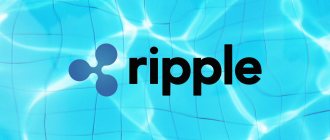Ripple or Ripple (translation into Russian - ripple) is a peer-to-peer ecosystem with a differentiated registry (a system of gateways or gates), which, unlike Bitcoin, does not use Blockchain technology. At the same time, the Ripple cryptocurrency is in many ways similar to Bitcoin - it is the absolute decentralization of the virtual architecture, the presence of an intra-system coin.
The official website of Ripple is ripple.com.
According to the developers themselves, the project was created as a kind of addition to the “cue ball”, but in no case as a competitor to Bitcoin. The fundamental goal of the project is to create a global “web” within which ecosystem clients can actively exchange digitized assets. At the same time, the task of increasing the processing speed and throughput capabilities of transactions with a radical reduction in commission fees for each financial transaction in the interbank sphere is a priority. Let’s take a closer look at this digital “miracle”: let’s look at the main parameters of the Ripple project, get acquainted with the history of its creation, pay attention to mining, and also talk about investment prospects.
Ripple XRP cryptocurrency price
| Name | Price | Market capitalization | Offers | Change % (7D) |
| Ripple XRP | $0.30 | $29,827,569,091.85 | 99991850794 XRP | +7.3% |
basic information
Information about the XRP cryptocurrency as of July 17, 2019:
| Name | Ripple (Russian Ripple) |
| Ticker | XRP |
| Type | Cryptocurrency |
| Capitalization | $13 638 547 980 |
| Number of transactions per second | 1500 |
| Confirmation time for one block | 0,06 |
| Cost | $0.3196 |
| Current issue | 42,811,861,267 XRP |
| Maximum emission | 100,000,000,000 XRP |
| Consensus algorithm | Ripple Protocol consensus algorithm |
| Mining algorithm | XRP Ledger Consensus Protocol |
| Website | https://ripple.com/ |
| Launch year | 2012 |
| A country | USA |
| CEO | Brad Garlinghouse |
| Blockchain Explorer | https://xrpcharts.ripple.com/#/graph/ |
| https://twitter.com/Ripple | |
| Exchanges for buying/selling cryptocurrency | EXMO, Binance, Bitmex, Livecoin, STEX, Currency, DSX, Bitforex, Kucoin, Okex, Cex io, Huobi, BitMax, Gate, etc. |
History of Ripple
Historical background of Ripple . Despite the fact that the year 2012 is considered to be the founding date of the Ripple cryptocurrency, in fairness it should be noted: at the beginning of the 2000s (2004), Ryan Fugger (a Canadian programmer from Vancouver) announced a new project for its development, which in 2005 took the form of an electronic payment system called "RipplePay". The project developed “sluggishly” due to almost zero public interest.
After 7 years, the project was noticed by Jed McCaleb (founder of the MtGox exchange) and other investors. After a financial injection and modification of the existing platform, an updated ecosystem emerged that literally burst into the top three cryptocurrencies by capitalization.
How XRP relates to Ripple's core services
Ripple is truly on the rise. The company managed to attract new investors (which led to an increase in the value of XRP exceeding 1000%) and new clients, including Cambridge Global Payments, the Central Bank of Saudi Arabia, banks in Japan, South Korea, Thailand and other large financial institutions. The San Francisco-based blockchain startup really managed to steal the spotlight this year.
However, it must be remembered that most of this attention was attracted by Ripple's bold claims that its technologies would revolutionize the field of international payment systems, radically updating the outdated mechanisms of communication and movement of amounts between financial giants. According to Ripple, its products are not only cheaper and faster to operate, but also generally more effective than anything the market offers. By and large, this statement is supported by its own cryptocurrency and blockchain.
But it's not that simple. On the one hand, the software developed by Ripple is far from XRP with its market capitalization of $35 billion. On the other hand, the token is only a small part of the company’s business, and it is far from completely tied to cryptocurrency. To help you better understand how XRP relates to Ripple's core services, here is a translation of an analytical article about xCurrent, xRapid and xVia - and how XRP fits into this “triangle”.
xCurrent
Built on the Interledger distributed ledger, xCurrent aims to provide interoperability for all currencies, not just crypto assets. Thanks to a system of connecting nodes containing data on the value of certain currencies, xCurrent allows banks to seamlessly process transfers, even if the sender's currency is US dollars and the recipient needs euros.
The system also includes a special messenger for coordinating information exchange between banks. The functionality of the messenger allows you to make instant changes so that basic errors (for example, a typo in the recipient's name) do not delay the transfer. In addition, the transactions themselves can be monitored at every stage without the risk of violating customer confidentiality.
Thus, XRP owes some of its popularity to xCurrent clients, although the system itself is in no way tied exclusively to cryptocurrencies. However, XRP can be the subject of a transaction based on this system, as can dollars, euros, bitcoin and ethereum.
xRapid
For one reason or another, Ripple has collected the base for transfers of its own token into a separate product called xRapid. The system allows clients to transfer assets to (or vice versa) XRP and send them at higher speeds through the xCurrent payment protocol without linking capital to nostro and loro accounts. In turn, the movement of XRP caused by the activity of large companies will increase market demand for the token.
According to Ripple Chief Technology Officer Stefan Thomas, the system is universal, but XRP has advantages:
“While the system in principle supports any digital asset, transfers to XRP are much faster and cheaper—one transaction costs a fraction of a penny and takes only three seconds.”
Currently, xRapid is used by money intermediary companies Western Union and Moneygram, as well as the Mexican bank Cuallix.
For Ripple, xRapid is the embodiment of the RippleNet program, according to which XRP becomes the central asset that unites all unique payment protocols.
xVia
Caring about convenience and ensuring customer loyalty, Ripple is actively promoting xVia, a payment interface that simplifies working with xCurrent and xRapid. Just as the complex inner workings of instant messaging are hidden behind the nice skin of WhatsApp, xVia masks the technological side of Ripple's payment systems. By default, xVia does not use XRP, although there is such an option. Like xCurrent, xVia allows you to track customer payments and even generate invoices for transactions.
Despite the fact that the main goal of the product is simplification, users still do not fully understand what it essentially is. In a Ripple thread on Reddit, a company representative responded that this is the coordinator of the transfers themselves. However, confusion may also be caused by the meager amount of information available about xVia.
Stay in touch! Subscribe to Cryptocurrency.Tech on Telegram
Features of Ripple
The Ripple cryptocurrency is a P2P design in its classic form, allowing the exchange of values within its borders without the presence of funds or third parties. For example, 2 ecosystem participants want to exchange, but do not have the funds. But one has a pear worth 5 bucks, and the other is the owner of a theater ticket, the price of which is $10. One is interested in the pear, the other is ready to get rid of it for a ticket. The lack of funds eliminates such an exchange in the traditional EPS (electronic payment system). However, in Ripple, this operation is as easy as pie: the ticket owner gives the countermark to the owner of the pear, and in return receives a piece of fruit and a promissory note for 5 “bucks.”
In fact, the example given is a simplified algorithm, the Ripple cryptocurrency carries out multi-stage exchanges from one user to another until the last one in the chain (ring) receives the desired asset from the previous client and gives the necessary “value” to the first user. At the same time, the entire multi-stage transaction is carried out at lightning speed; there is no need to look for candidates for exchange, since the system does this automatically. As a result, all participants in the “ring” receive the necessary assets without the intervention of intermediaries, that is, without commission fees.
In addition, within the boundaries of the XPR cryptocurrency there is a virtual structure called RippleNet, which unites transaction providers, banking structures, and corporations. Finances sent on this network are tracked from anywhere on the planet, and an individual interface has been developed for each category of users, allowing them to solve specific problems:
- This software was created for interbank relationships.
- The resource provides liquidity for transaction providers.
- XVia is a service for all ecosystem clients that makes payments with the ability to subsequently track the financial transaction and confirm the transaction. To make using the resource more comfortable, you can add an invoice or other payment transaction documents to its interface.
The final feature of the XRP cryptocurrency is its open API, through which decentralized application (DApp) developers can connect to the ecosystem, receiving all the virtual architecture information.
Magento (a service that monitors the activities of virtual trading platforms) and Ripple Wallet, an electronic wallet for paying for goods and services with XRP, were among the first to use this option. Important! Mining of the XRP cryptocurrency is not included in the concept of the ecosystem; it does not need “miners” to maintain the effective functionality of the digital architecture and the security of the virtual structure as a whole. You can purchase a coin on any cryptocurrency exchange: Gate, Bitmax, Bibox, BitForex, ABCC and other platforms. The Bitmex exchange is perfect for margin trading.
Ripple cryptocurrency rate
Today (September 27, 2018) the Ripple cryptocurrency is trading at 0.52 USD. Over the 5 years since the start of trading, the value has increased 88 times or 8783%. The initial price of XRP was $0.0059. Let us remind you that the first coin trading took place in August 2013.
The maximum price for the Ripple cryptocurrency was observed in January 2018. The token price reached $3.65. During the period January-September, Ripple quotes “fell” by more than 85% from their maximum values.
The largest price increase (806%) was recorded in December 2017, the maximum drawdown (-68%) was in January 2020.
On December 13, 2020, the rate increased by a record 78% per day. The maximum drop (-26%) was January 16, 2020.
In continuation: Ripple to dollar exchange rate and chart online.
Ripple Storage Wallet
There is no official wallet for the Ripple cryptocurrency. The developers didn't bother to create it. To store cryptocoins, the Ripple Trade platform was previously used, on which it was possible to hold cryptocurrencies. Since 2016, the trading service has been closed, and officials have suggested using other storage facilities.
The official Ripple website provided an answer to the question “where to store XRP and which wallet to use”:
The developers are not responsible for the operation of third-party storage services and recommend conducting reliability checks before commencing operations.
Let's make a list of Ripple wallets:
- Local: Toast Wallet is an open source wallet for Windows, Mac, Linux.
- Online: Exarpy, Guarda, Toast (Chrome only), Bitpanda.
- Android, iOS applications: Toast Wallet, Zebpay, CoolWallet.
- Hardware wallets: Ledger, Trezor, Keepkey, CoolWallet S.
In continuation: Review of cryptocurrency wallets 2020.
Ripple rate
The cost of Ripple, like any other cryptocurrency, mainly changes during the release of important news: about concluding a partnership agreement with a large bank, speaking at a conference, or implementing some of the tasks specified in the roadmap. It is impossible to answer the question: “How many users does Ripple have”, because this number is constantly growing.
For example, we can take the end of 2014. At this time, Ripple signed a cooperation agreement with the large payment network Earthport and the price of Ripple rose by 200%. After this jump, Ripple overtook LiteCoin in capitalization, taking second place in the TOP cryptocurrency after Bitcoin. And when the news about the beginning of interaction with MoneeyGram appeared, the cost of RTX coin rose by 16% in one day.
The truly explosive growth began in December 2020, showing an increase in profitability for 2020 in the region of 34,000%.
The Ripple (XRP) rate as of July 1, 2020 is $0.456123. On January 4, 2020, there was a jump in price to 3.6491. After which, over the course of a month, the cryptocurrency lost value, leveling off at $0.8. After which, it has been 4 months without any drastic changes.
Ripple's capitalization is $23,675,530,650;
The company decided to imitate 100% of the coins at a time, without further mining. You can find out how many coins there are on the official website of the platform. Their number is 100,000,000,000 tokens.
If you look at the tasks set by the developers, and at the pace of implementation and implementation of cryptocurrency in the industry, we can assume with great confidence that cryptocurrency has very positive prospects. Technical analysis of Ripple, as well as for other cryptocurrencies, will not be able to tell much about price movement. You need to be interested in news that will tell you the exact direction of price movement.
Some enthusiasts have voiced predictions that the coin could rise to $1,000 in 2020. Those who are more reserved about this cryptocurrency voice a figure of $100. However, the developers do not position their brainchild as a cryptocurrency. For them, the main thing is the performance of their network. Therefore, such an increase in price is not profitable for them. However, we should expect positive trends in the value of Ripple.
Ripple exchanges for trading
Today, the main volume of trading in the Ripple cryptocurrency falls on the following exchanges:
- Binance. XRP/USDT pair – 12.52% of total trading volume.
- Bitbank. XRP/JPY - 11.65%.
- Upbit. XRP/KRW - 10.94%.
The most popular Ripple exchanges for fiat (you can make deposits/withdrawals in US dollars, rubles, etc.):
- Exmo.
- Cex.io.
- Livecoin.
- Yobit.
On crypto exchanges you can get a free wallet to store XRP without paying 20 XRP. Choose a reliable site that has been operating for more than one year and has a good reputation.
Interface
The starting window is practically no different from Ethereum or other cryptocurrencies. Our active accounts are visible on the left. You can add another one if you have the existing balance of the previous one.
The Summary tab displays the current balance in fiat currency, the reserve amount of 20 XRP and the current exchange rate.
Before using the account, you must make a deposit of 20XRP. This is a prerequisite that was created to protect the network from various types of attacks. The deposit cannot be spent in the future.
How to buy and sell cryptocurrency Ripple (XRP)
There are two main ways to buy or sell Ripple cryptocurrency:
- Crypto exchanges.
- Exchangers.
Before starting the operation, you should analyze the commissions and rates in order to understand where to buy Ripple or sell the coin more profitably. The cryptocurrency rate will be better on exchanges, but do not forget that you need to pay a commission for input/withdrawal. When exchanging for fiat, its value can be significant. Another nuance: not all crypto exchanges work with ordinary money: rubles, dollars, etc.
You can sell Ripple in an exchanger much faster, and the number of payment systems and directions is wider: bank cards, Yandex.Money, Qiwi and others. Now cryptocurrency exchangers create real competition for exchanges and exchanges with them are profitable. The downside is that to purchase you must already have a wallet address to receive Ripple.
You can get Ripple for free on faucet sites, but the payouts are very small and should not be considered as a way to earn money.





